Table of Contents
- about dns
- dns namespace
- caching only servers
- authoritative dns servers
- primary and secondary
- zone transfers
- master and slave
- SOA record
- full or incremental zone transfers
- DNS cache
- forward lookup zone example
- example: caching only DNS server
- example: caching only with forwarder
- example: primary authoritative server
- example: a DNS slave server
- practice: dns
- solution: dns
dns is a fundamental part of every large computer network. dns is used by many network services to translate names into network addresses and to locate services on the network (by name).
Whenever you visit a web site, send an e-mail, log on to Active Directory, play Minecraft, chat, or use VoIP, there will be one or (many) more queries to dns services.
Should dns fail at your organization, then the whole network will grind to a halt (unless you hardcoded the network addresses).
You will notice that even the largest of organizations benefit greatly from having one dns infrastructure. Thus dns requires all business units to work together.
Even at home, most home modems and routers have builtin dns functionality.
This module will explain what dns actually is and how to set it up using Linux and bind9.
The domain name system or dns is a service on a tcp/ip network that enables clients to translate names into ip addresses. Actually dns is much more than that, but let's keep it simple for now.
When you use a browser to go to a website, then you type the name of that website in the url bar. But for your computer to actually communicate with the web server hosting said website, your computer needs the ip address of that web server. That is where dns comes in.
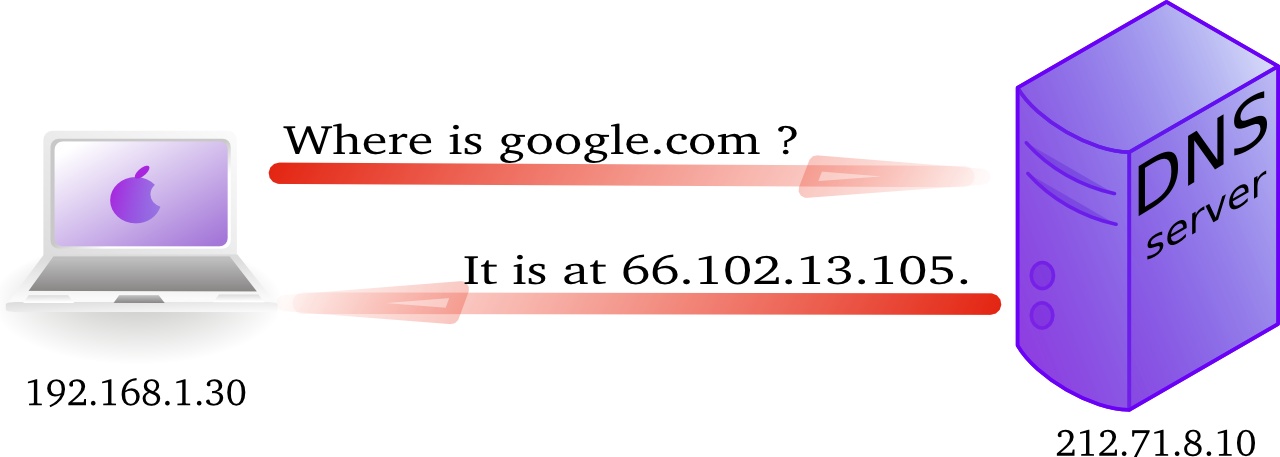
In wireshark you can use the dns filter to see this traffic.

In the Seventies, only a few hundred computers were connected to the internet. To resolve names, computers had a flat file that contained a table to resolve hostnames to ip addresses. This local file was downloaded from hosts.txt on an ftp server in Stanford.
In 1984 Paul Mockapetris created dns, a distributed treelike hierarchical database that will be explained in detail in these chapters.
Today, dns or domain name system is a worldwide distributed hierarchical database controlled by ICANN. Its primary function is to resolve names to ip addresses, and to point to internet servers providing smtp or ldap services.
The old hosts.txt file is still active today on most computer systems under the name /etc/hosts (or C:/Windows/System32/Drivers/etc/hosts). We will discuss this file later, as it can influence name resolution.
The question a client asks a dns server is called a query. When a client queries for an ip address, this is called a forward lookup query (as seen in the previous drawing).
The reverse, a query for the name of a host, is called a reverse lookup query.
Below a picture of a reverse lookup query.
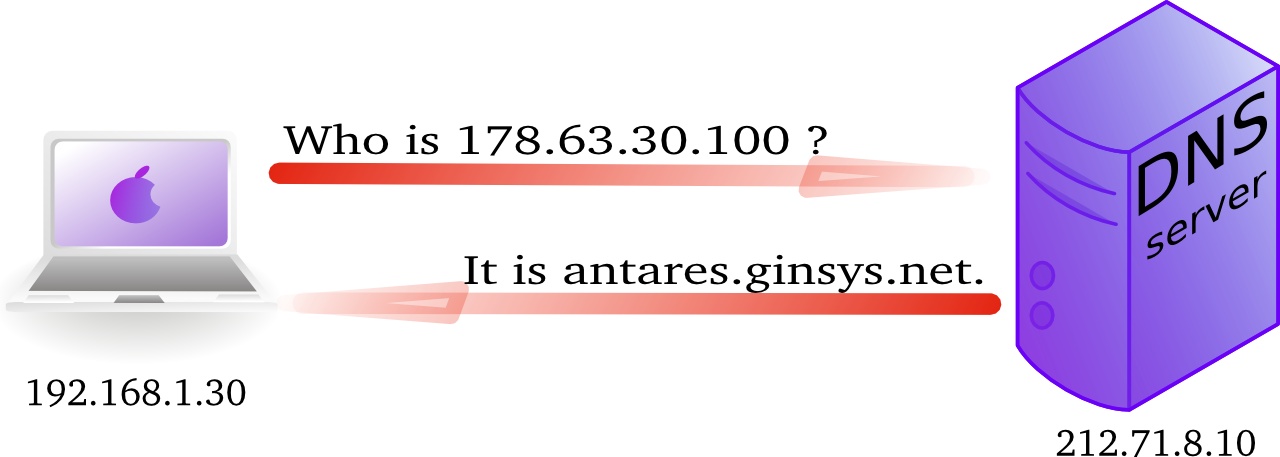
Here is a screenshot of a reverse lookup query in nslookup.
root@debian7:~# nslookup
> set type=PTR
> 188.93.155.87
Server: 192.168.1.42
Address: 192.168.1.42#53
Non-authoritative answer:
87.155.93.188.in-addr.arpa name = antares.ginsys.net.This is what a reverse lookup looks like when sniffing with tcpdump.
root@debian7:~# tcpdump udp port 53
tcpdump: verbose output suppressed, use -v or -vv for full protocol decode
listening on eth0, link-type EN10MB (Ethernet), capture size 65535 bytes
11:01:29.357685 IP 192.168.1.103.42041 > 192.168.1.42.domain: 14763+ PT\
R? 87.155.93.188.in-addr.arpa. (44)
11:01:29.640093 IP 192.168.1.42.domain > 192.168.1.103.42041: 14763 1/0\
/0 PTR antares.ginsys.net. (76)And here is what it looks like in wireshark (note this is an older screenshot).

A client computer needs to know the ip address of the dns server to be able to send queries to it. This is either provided by a dhcp server or manually entered.
Linux clients keep this information in the /etc/resolv.conf file.
root@debian7:~# cat /etc/resolv.conf
domain linux-training.be
search linux-training.be
nameserver 192.168.1.42
root@debian7:~#You can manually change the ip address in this file to use another dns server. For example Google provides a public name server at 8.8.8.8 and 8.8.4.4.
root@debian7:~# cat /etc/resolv.conf
nameserver 8.8.8.8
root@debian7:~#Please note that on dhcp clients this value can be overwritten when the dhcp lease is renewed.
The dns namespace is hierarchical tree structure, with the root servers (aka dot-servers) at the top. The root servers are usually represented by a dot.
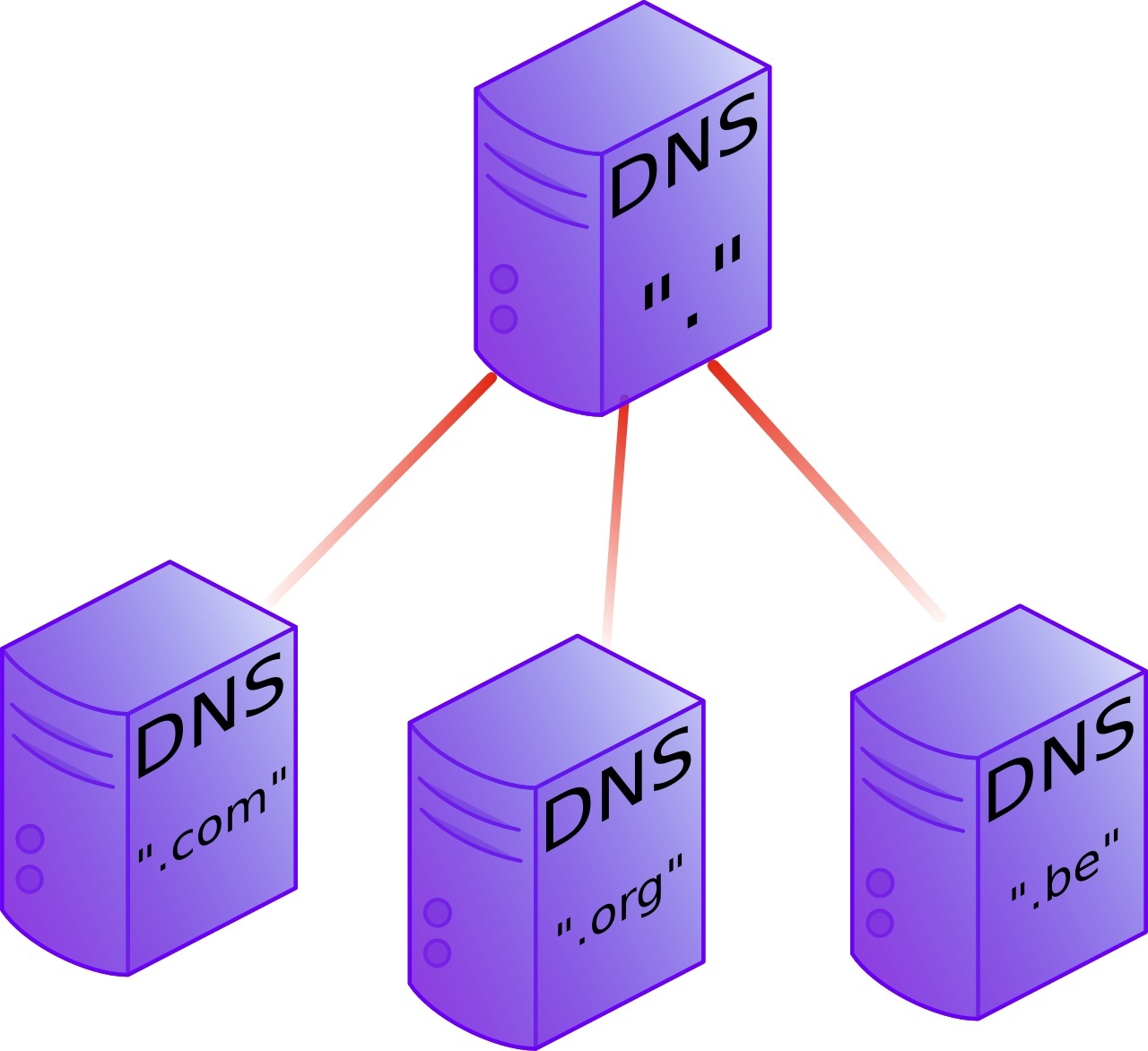
Below the root-servers are the Top Level Domains or tld's.
There are more tld's than shown in the picture. Currently about 200 countries have a tld. And there are several general tld's like .com, .edu, .org, .gov, .net, .mil, .int and more recently also .aero, .info, .museum, ...
There are thirteen root servers on the internet, they are named A to M. Journalists often refer to these servers as the master servers of the internet, because if these servers go down, then nobody can (use names to) connect to websites.
The root servers are not thirteen physical machines, they are many more. For example the F root server consists of 46 physical machines that all behave as one (using anycast).
http://root-servers.org http://f.root-servers.org http://en.wikipedia.org/wiki/Root_nameserver.
Every dns server software will come with a list of root hints to locate the root servers.
This screenshot shows a small portion of the root hints file that comes with bind 9.8.4.
root@debian7:~# grep -w 'A ' /etc/bind/db.root
A.ROOT-SERVERS.NET. 3600000 A 198.41.0.4
B.ROOT-SERVERS.NET. 3600000 A 192.228.79.201
C.ROOT-SERVERS.NET. 3600000 A 192.33.4.12
D.ROOT-SERVERS.NET. 3600000 A 199.7.91.13
E.ROOT-SERVERS.NET. 3600000 A 192.203.230.10
F.ROOT-SERVERS.NET. 3600000 A 192.5.5.241
G.ROOT-SERVERS.NET. 3600000 A 192.112.36.4
H.ROOT-SERVERS.NET. 3600000 A 128.63.2.53
I.ROOT-SERVERS.NET. 3600000 A 192.36.148.17
J.ROOT-SERVERS.NET. 3600000 A 192.58.128.30
K.ROOT-SERVERS.NET. 3600000 A 193.0.14.129
L.ROOT-SERVERS.NET. 3600000 A 199.7.83.42
M.ROOT-SERVERS.NET. 3600000 A 202.12.27.33
root@debian7:~#One level below the top level domains are the domains. Domains can have subdomains (also called child domains).
This picture shows dns domains like google.com, chess.com, linux-training.be (there are millions more).
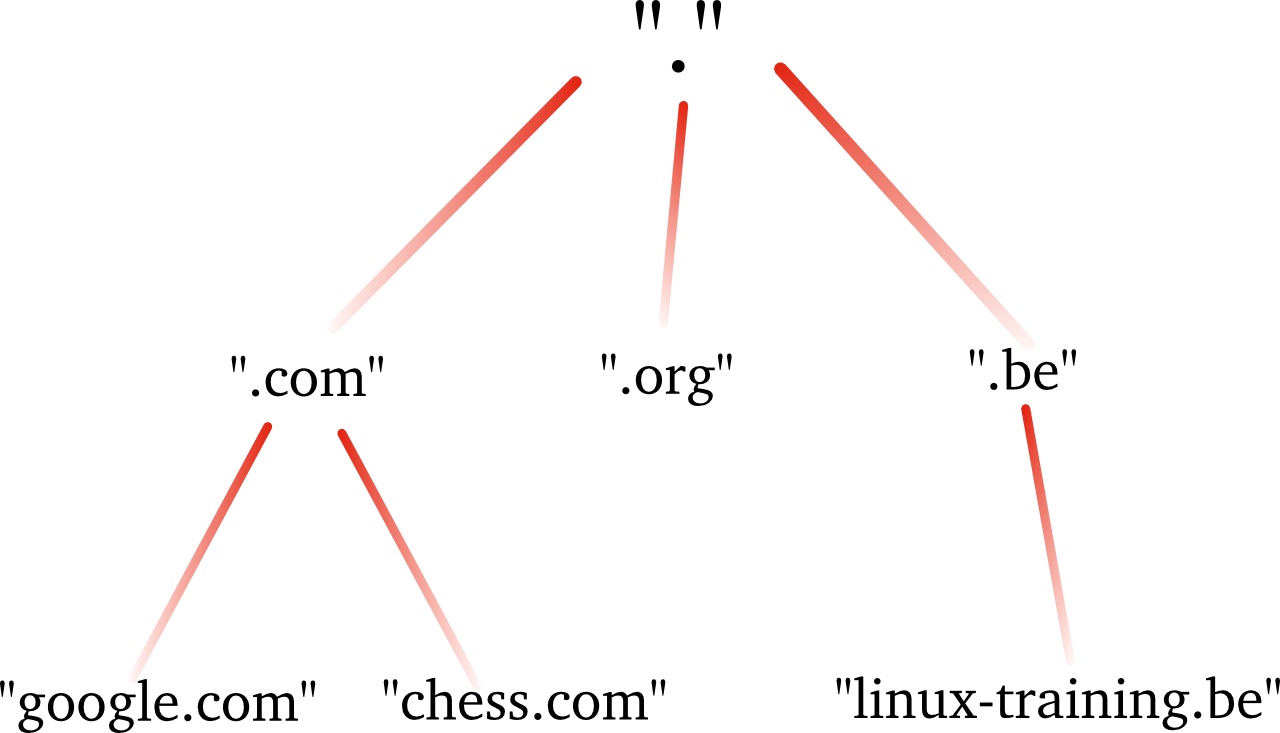
DNS domains are registered at the tld servers, the tld servers are registered at the dot servers.
Below the root level are the top level domains or tld's. Originally there were only seven defined:
Table 10.1. the first top level domains
| year | TLD | purpose |
|---|---|---|
| 1985 | .arpa | Reverse lookup via in-addr.arpa |
| 1985 | .com | Commercial Organizations |
| 1985 | .edu | US Educational Institutions |
| 1985 | .gov | US Government Institutions |
| 1985 | .mil | US Military |
| 1985 | .net | Internet Service Providers, Internet Infrastructure |
| 1985 | .org | Non profit Organizations |
| 1988 | .int | International Treaties like nato.int |
Country tld's were defined for individual countries, like .uk in 1985 for Great Britain (yes really), .be for Belgium in 1988 and .fr for France in 1986. See RFC 1591 for more info.
In 1998 seven new general purpose tld's where chosen, they became active in the 21st century.
Table 10.2. new general purpose tld's
| year | TLD | purpose |
|---|---|---|
| 2002 | .aero | aviation related |
| 2001 | .biz | businesses |
| 2001 | .coop | for co-operatives |
| 2001 | .info | informative internet resources |
| 2001 | .museum | for museums |
| 2001 | .name | for all kinds of names, pseudonyms and labels... |
| 2004 | .pro | for professionals |
Many people were surprised by the choices, claiming not much use for them and wanting a separate .xxx domain (introduced in 2011) for adult content, and .kidz a save haven for children. In the meantime more useless tld's were create like .travel (for travel agents) and .tel (for internet communications) and .jobs (for jobs sites).
In 2012 ICANN released a list of 2000 new tld's that would gradually become available.
The fully qualified domain name or fqdn is the combination of the hostname of a machine appended with its domain name.
If for example a system is called gwen and it is in the domain linux-training.be, then the fqdn of this system is gwen.linux-training.be.
On Linux systems you can use the hostname and dnsdomainname commands to verify this information.
root@gwen:~# hostname gwen root@gwen:~# dnsdomainname linux-training.be root@gwen:~# hostname --fqdn gwen.linux-training.be root@gwen:~# cat /etc/debian_version 6.0.10
A zone (aka a zone of authority) is a portion of the DNS tree that covers one domain name or child domain name. The picture below represents zones as blue ovals. Some zones will contain delegate authority over a child domain to another zone.
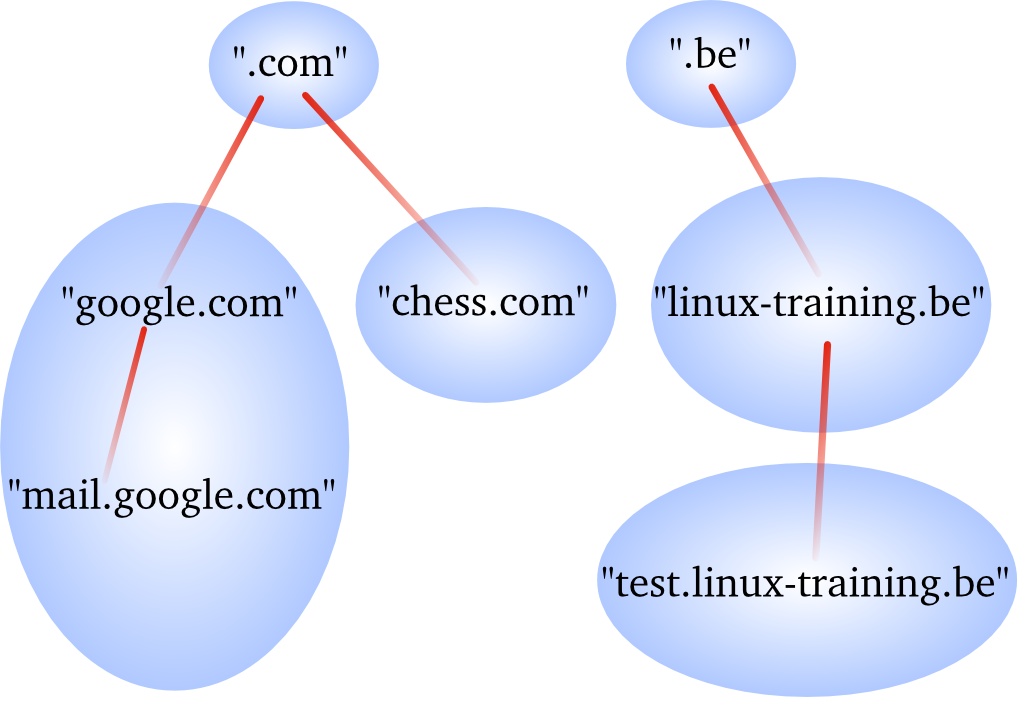
A dns server can be authoritative over 0, 1 or more dns zones. We will see more details later on the relation between a dns server and a dns zone.
A dns zone consists of records, also called resource records. We will list some of those resource records on the next page.
The A record, which is also called a host record contains the ipv4-address of a computer. When a DNS client queries a DNS server for an A record, then the DNS server will resolve the hostname in the query to an ip address. An AAAA record is similar but contains an ipv6 address instead of ipv4.
A PTR record is the reverse of an A record. It contains the name of a computer and can be used to resolve an ip address to a hostname.
A NS record or nameserver record is a record that points to a DNS name server (in this zone). You can list all your name servers for your DNS zone in distinct NS records.
The SOA record of a zone contains meta information about the zone itself. The contents of the SOA record is explained in detail in the section about zone transfers. There is exactly one SOA record for each zone.
A dns server that is set up without authority over a zone, but that is connected to other name servers and caches the queries is called a caching only name server. Caching only name servers do not have a zone database with resource records. Instead they connect to other name servers and cache that information.
There are two kinds of caching only name servers. Those with a forwarder, and those that use the root servers.
A caching only server without forwarder will have to get information elsewhere. When it receives a query from a client, then it will consult one of the root servers. The root server will refer it to a tld server, which will refer it to another dns server. That last server might know the answer to the query, or may refer to yet another server. In the end, our hard working dns server will find an answer and report this back to the client.
In the picture below, the clients asks for the ip address of linux-training.be. Our caching only server will contact the root server, and be refered to the .be server. It will then contact the .be server and be refered to one of the name servers of Openminds. One of these name servers (in this cas ns1.openminds.be) will answer the query with the ip address of linux-training.be. When our caching only server reports this to the client, then the client can connect to this website.
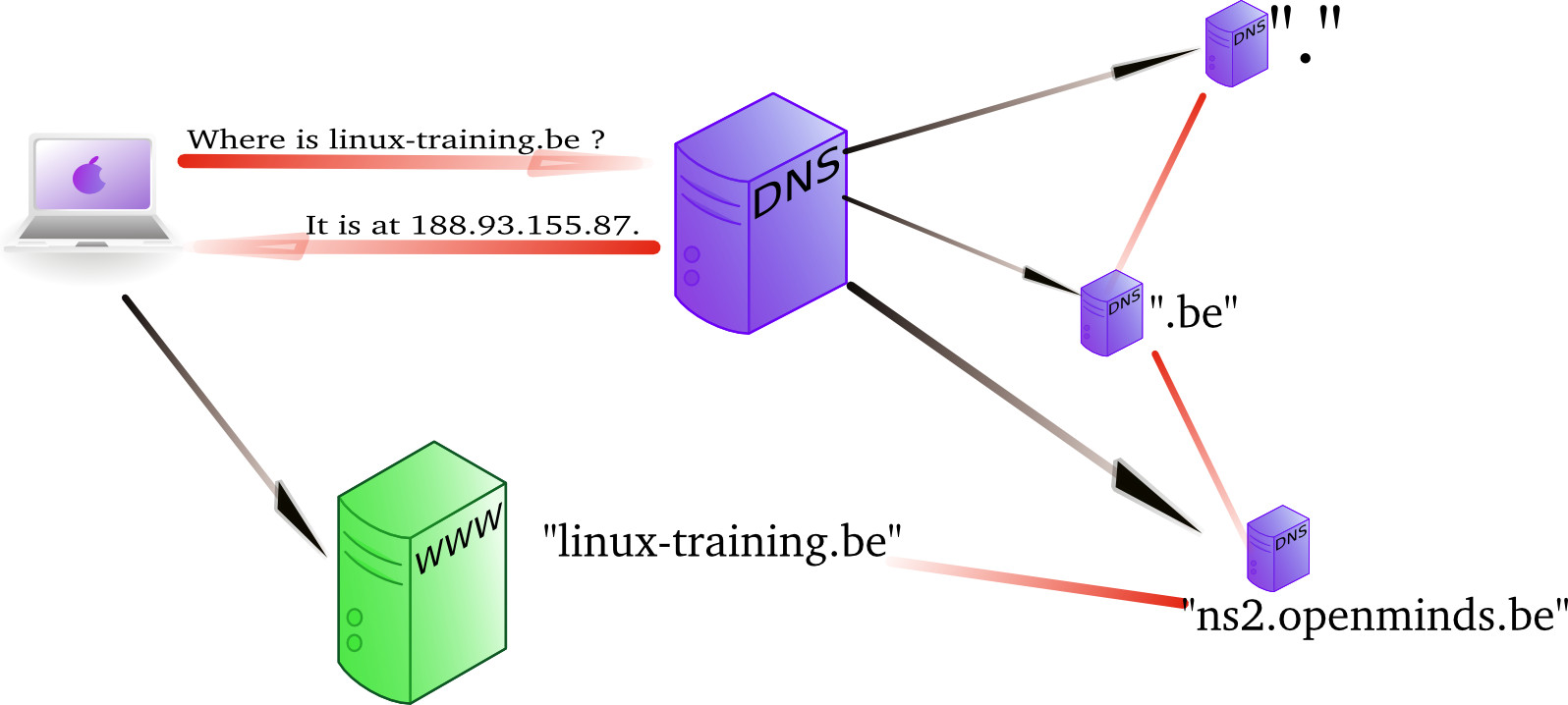
Sniffing with tcpdump will give you this (the first 20 characters of each line are cut).
192.168.1.103.41251 > M.ROOT-SERVERS.NET.domain: 37279% [1au] A? linux-tr\ aining.be. (46) M.ROOT-SERVERS.NET.domain > 192.168.1.103.41251: 37279- 0/11/13 (740) 192.168.1.103.65268 > d.ns.dns.be.domain: 38555% [1au] A? linux-training.\ be. (46) d.ns.dns.be.domain > 192.168.1.103.65268: 38555- 0/7/5 (737) 192.168.1.103.7514 > ns2.openminds.be.domain: 60888% [1au] A? linux-train\ ing.be. (46) ns2.openminds.be.domain > 192.168.1.103.7514: 60888*- 1/0/1 A 188.93.155.\ 87 (62)
A caching only server with a forwarder is a DNS server that will get all its information from the forwarder. The forwarder must be a dns server for example the dns server of an internet service provider.

This picture shows a dns server on the company LAN that has set the dns server from their isp as a forwarder. If the ip address of the isp dns server is 212.71.8.10, then the following lines would occur in the named.conf file of the company dns server:
forwarders {
212.71.8.10;
};You can also configure your dns server to work with conditional forwarder(s). The definition of a conditional forwarder looks like this.
zone "someotherdomain.local" {
type forward;
forward only;
forwarders { 10.104.42.1; };
};A recursive query is a DNS query where the client that is submitting the query expects a complete answer (Like the fat red arrow above going from the Macbook to the DNS server). An iterative query is a DNS query where the client does not expect a complete answer (the three black arrows originating from the DNS server in the picture above). Iterative queries usually take place between name servers. The root name servers do not respond to recursive queries.
A DNS server that is controlling a zone, is said to be the authoritative DNS server for that zone. Remember that a zone is a collection of resource records.
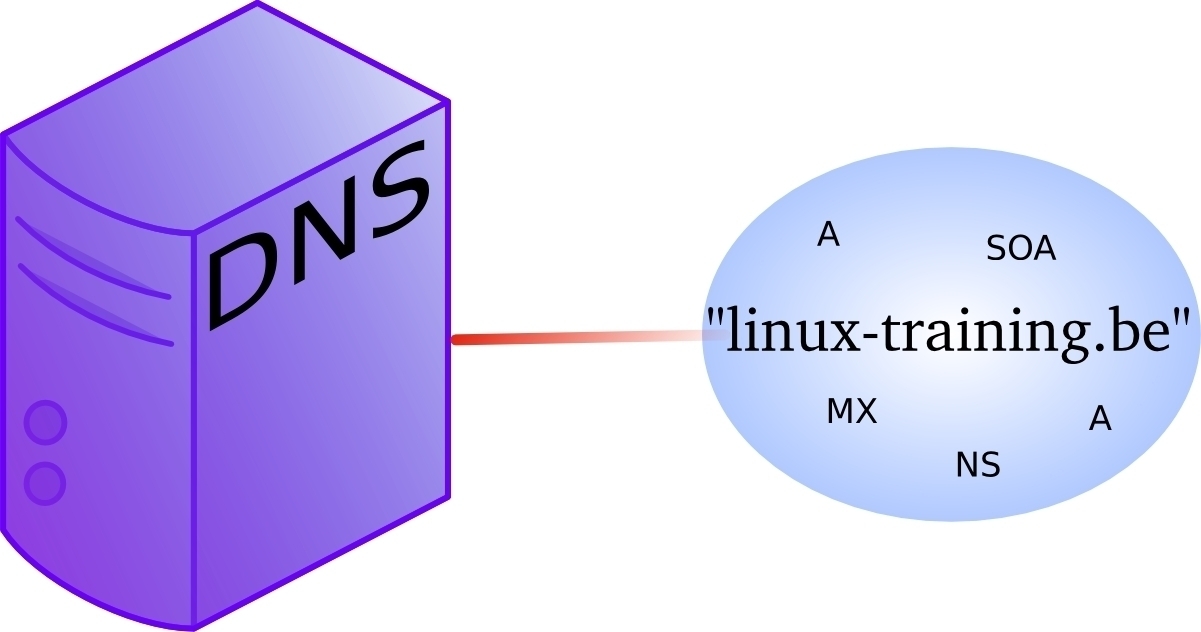
When you set up the first authoritative dns server for a zone, then this is called the primary dns server. This server will have a readable and writable copy of the zone database. For reasons of fault tolerance, performance or load balancing you may decide to set up another dns server with authority over that zone. This is called a secondary dns server.

The slave server receives a copy of the zone database from the master server using a zone transfer. Zone transfers are requested by the slave servers at regular intervals. Those intervals are defined in the soa record.
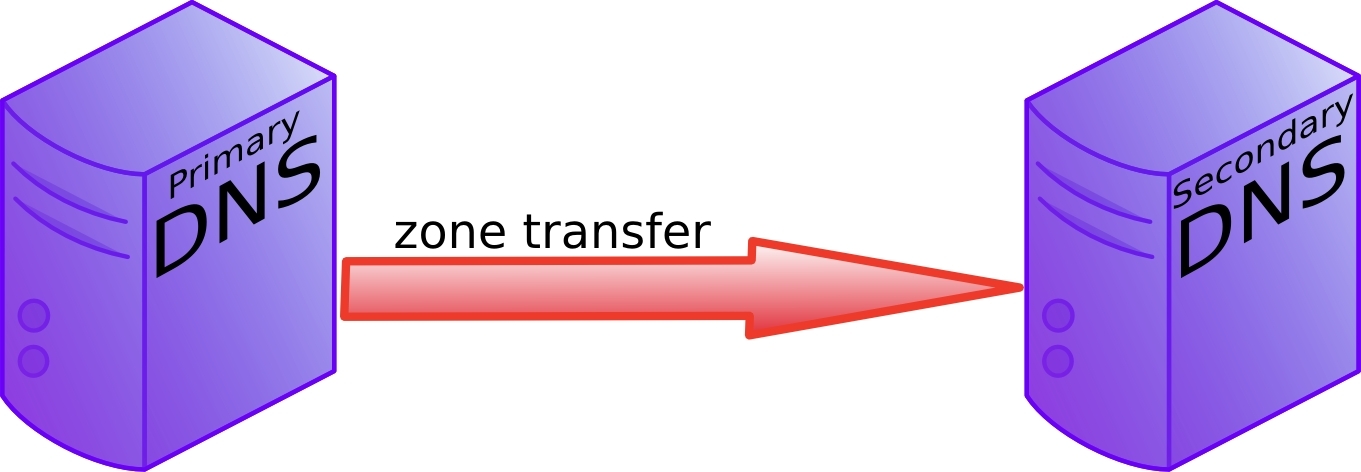
You can force a refresh from a zone with rndc. The example below force a transfer of the fred.local zone, and shows the log from /var/log/syslog.
root@debian7:/etc/bind# rndc refresh fred.local root@debian7:/etc/bind# grep fred /var/log/syslog | tail -7 | cut -c38- zone fred.local/IN: sending notifies (serial 1) received control channel command 'refresh fred.local' zone fred.local/IN: Transfer started. transfer of 'fred.local/IN' from 10.104.109.1#53: connected using 10.104.33.30#57367 zone fred.local/IN: transferred serial 2 transfer of 'fred.local/IN' from 10.104.109.1#53: Transfer completed: 1 messages, 10 records, 264 bytes, 0.001 secs (264000 bytes/sec) zone fred.local/IN: sending notifies (serial 2) root@debian7:/etc/bind#
When adding a secondary dns server to a zone, then you will configure this server as a slave server to the primary server. The primary server then becomes the master server of the slave server.
Often the primary dns server is the master server of all slaves. Sometimes a slave server is master server for a second line slave server. In the picture below ns1 is the primary dns server and ns2, ns3 and ns4 are secondaries. The master for slaves ns2 and ns3 is ns1, but the master for ns4 is ns2.
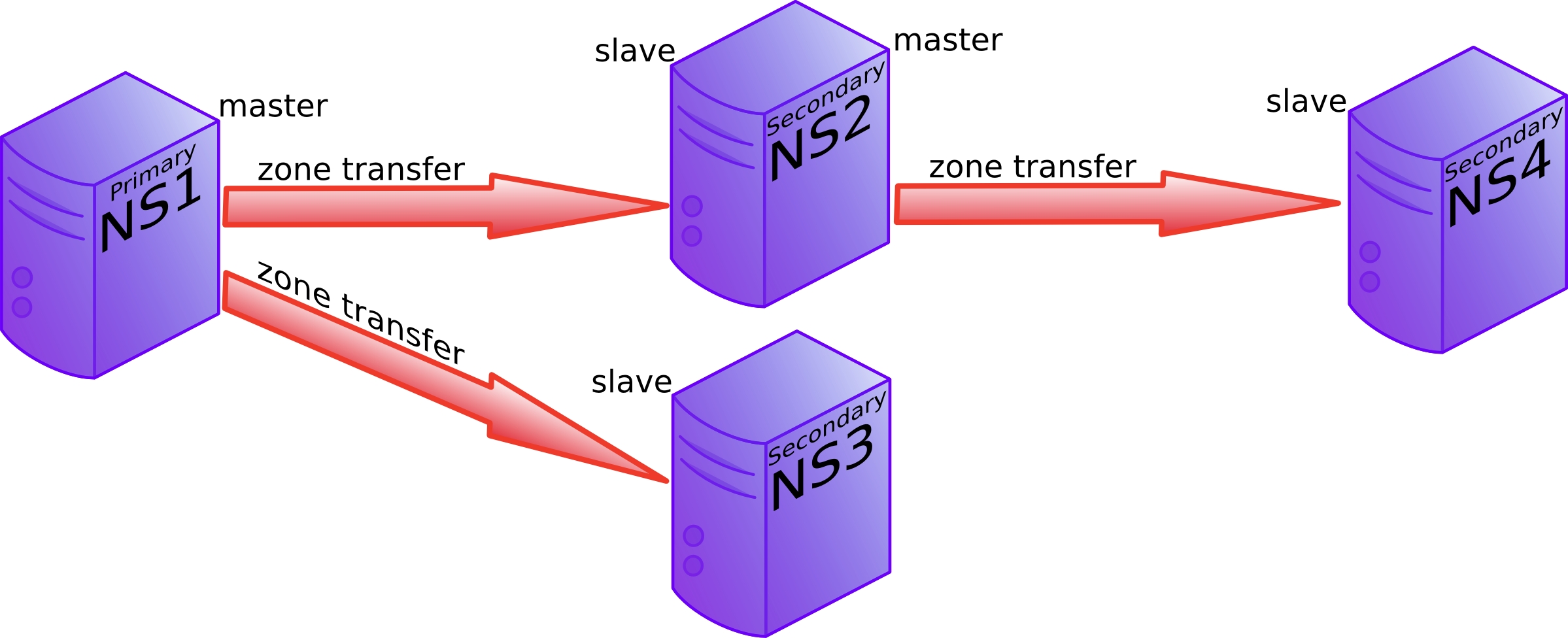
The soa record contains a refresh value. If this is set to 30 minutes, then the slave server will request a copy of the zone file every 30 minutes. There is also a retry value. The retry value is used when the master server did not reply to the last zone transfer request. The value for expiry time says how long the slave server will answer to queries, without receiving a zone update.
Below an example of how to use nslookup to query the soa record of a zone (linux-training.be).
root@debian6:~# nslookup > set type=SOA > server ns1.openminds.be > linux-training.be Server: ns1.openminds.be Address: 195.47.215.14#53 linux-training.be origin = ns1.openminds.be mail addr = hostmaster.openminds.be serial = 2321001133 refresh = 14400 retry = 3600 expire = 604800 minimum = 3600
Zone transfers only occur when the zone database was updated (meaning when one or more resource records were added, removed or changed on the master server). The slave server will compare the serial number of its own copy of the SOA record with the serial number of its master's SOA record. When both serial numbers are the same, then no update is needed (because no records were added, removed or deleted). When the slave has a lower serial number than its master, then a zone transfer is requested.
Below a zone transfer captured in wireshark.
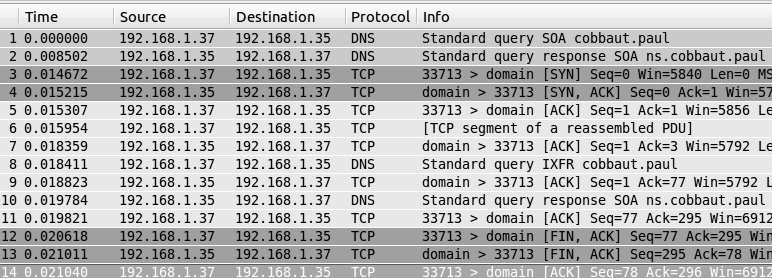
When a zone tranfer occurs, this can be either a full zone transfer or an incremental zone transfer. The decision depends on the size of the transfer that is needed to completely update the zone on the slave server. An incremental zone transfer is prefered when the total size of changes is smaller than the size of the zone database. Full zone transfers use the axfr protocol, incremental zone transfer use the ixfr protocol.
DNS is a caching protocol.
When a client queries its local DNS server, and the local DNS server is not authoritative for the query, then this server will go looking for an authoritative name server in the DNS tree. The local name server will first query a root server, then a tld server and then a domain server. When the local name server resolves the query, then it will relay this information to the client that submitted the query, and it will also keep a copy of these queries in its cache. So when a(nother) client submits the same query to this name server, then it will retrieve this information form its cache.
For example, a client queries for the A record on www.linux-training.be to its local server. This is the first query ever received by this local server. The local server checks that it is not authoritative for the linux-training.be domain, nor for the .be tld, and it is also not a root server. So the local server will use the root hints to send an iterative query to a root server.
The root server will reply with a reference to the server that is authoritative for the .be domain (root DNS servers do not resolve fqdn's, and root servers do not respond to recursive queries).
The local server will then sent an iterative query to the authoritative server for the .be tld. This server will respond with a reference to the name server that is authoritative for the linux-training.be domain.
The local server will then sent the query for www.linux-training.be to the authoritative server (or one of its slave servers) for the linux-training.be domain. When the local server receives the ip address for www.linux-training.be, then it will provide this information to the client that submitted this query.
Besides caching the A record for www.linux-training.be, the local server will also cache the NS and A record for the linux-training.be name server and the .be name server.
The way to set up zones in /etc/bind/named.conf.local is to create a zone entry with a reference to another file (this other file contains the zone database).
Here is an example of such an entry in /etc/bind/named.conf.local:
root@debian7:~# cat /etc/bind/named.conf.local
//
// Do any local configuration here
//
// Consider adding the 1918 zones here, if they are not used in your
// organization
//include "/etc/bind/zones.rfc1918";
zone "paul.local" IN {
type master;
file "/etc/bind/db.paul.local";
allow-update { none; };
};
root@debian7:~#To create the zone file, the easy method is to copy an existing zone file (this is easier than writing from scratch).
root@debian7:/etc/bind# cp db.empty db.paul.local root@debian7:/etc/bind# vi db.paul.local
Here is an example of a zone file.
root@debian7:/etc/bind# cat db.paul.local
; zone for classroom teaching
$TTL 86400
@ IN SOA debianpaul.paul.local. root.paul.local (
2014100100 ; Serial
1h ; Refresh
1h ; Retry
2h ; Expire
86400 ) ; Negative Cache TTL
;
; name servers
;
IN NS ns1
IN NS debianpaul
IN NS debian7
;
; servers
;
debianpaul IN A 10.104.33.30
debian7 IN A 10.104.33.30
ns1 IN A 10.104.33.30
;www IN A 10.104.33.301. installing DNS software on Debian
root@debian7:~# aptitude update && aptitude upgrade ... root@debian7:~# aptitude install bind9 ... root@debian7:~# dpkg -l | grep bind9 | tr -s ' ' ii bind9 1:9.8.4.dfsg.P1-6+nmu2+deb7u2 amd64 Internet Domain Name Server ii bind9-host 1:9.8.4.dfsg.P1-6+nmu2+deb7u2 amd64 Version of 'host' bundled... ii bind9utils 1:9.8.4.dfsg.P1-6+nmu2+deb7u2 amd64 Utilities for BIND ii libbind9-80 1:9.8.4.dfsg.P1-6+nmu2+deb7u2 amd64 BIND9 Shared Library use... root@debian7:~#
2. Discover the default configuration files. Can you define the purpose of each file ?
root@debian7:~# ls -l /etc/bind
total 52
-rw-r--r-- 1 root root 2389 Sep 5 20:25 bind.keys
-rw-r--r-- 1 root root 237 Sep 5 20:25 db.0
-rw-r--r-- 1 root root 271 Sep 5 20:25 db.127
-rw-r--r-- 1 root root 237 Sep 5 20:25 db.255
-rw-r--r-- 1 root root 353 Sep 5 20:25 db.empty
-rw-r--r-- 1 root root 270 Sep 5 20:25 db.local
-rw-r--r-- 1 root root 3048 Sep 5 20:25 db.root
-rw-r--r-- 1 root bind 463 Sep 5 20:25 named.conf
-rw-r--r-- 1 root bind 490 Sep 5 20:25 named.conf.default-zones
-rw-r--r-- 1 root bind 374 Oct 1 20:01 named.conf.local
-rw-r--r-- 1 root bind 913 Oct 1 13:24 named.conf.options
-rw-r----- 1 bind bind 77 Oct 1 11:14 rndc.key
-rw-r--r-- 1 root root 1317 Sep 5 20:25 zones.rfc1913. Setup caching only dns server. This is normally the default setup. A caching-only name server will look up names for you and cache them. Many tutorials will tell you to add a forwarder, but we first try without this!
Hey this seems to work without a forwarder. Using a sniffer you can find out what really happens. Your freshly install dns server is not using a cache, and it is not using your local dns server (from /etc/resolv.conf). So where is this information coming from ? And what can you learn from sniffing this dns traffic ?
4. Explain in detail what happens when you enable a caching only dns server without forwarder. This wireshark screenshot can help, but you learn more by sniffing the traffic yourself.
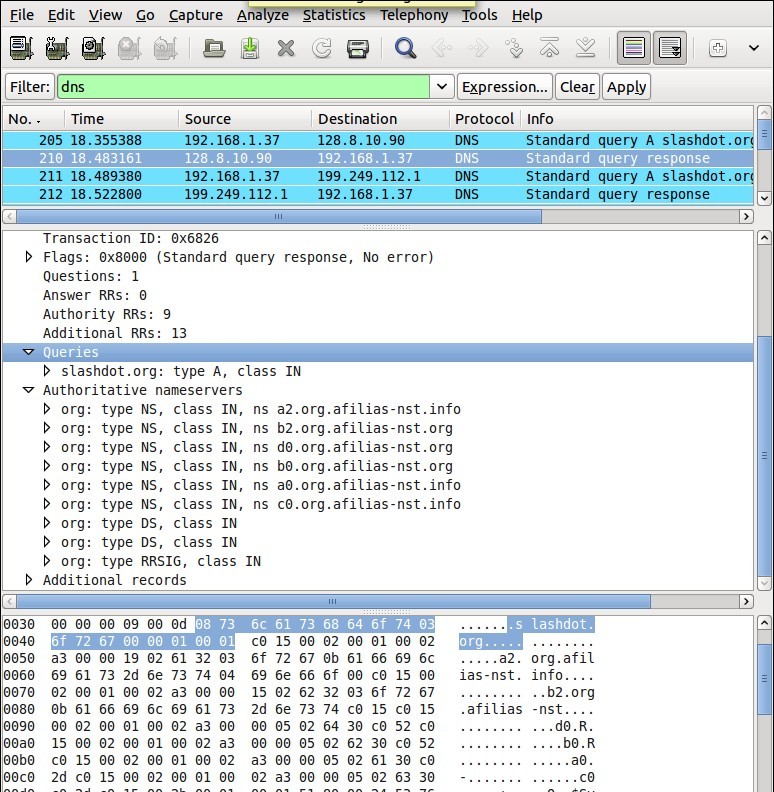
You should see traffic to a root name server whenever you try a new tld for the first time. Remember that dns is a caching protocol, which means that repeating a query will generate a lot less traffic since your dns server will still have the answer in its memory.
5. Add the public Google dns server as a forwarder. The ip address of this server is 8.8.8.8 .
Before the change:
root@debian7:~# grep -A2 'forwarders {' /etc/bind/named.conf.options
// forwarders {
// 0.0.0.0;
// };changing:
root@debian7:~# vi /etc/bind/named.conf.optionsAfter the change:
root@debian7:~# grep -A2 'forwarders {' /etc/bind/named.conf.options
forwarders {
8.8.8.8;
};Restart the server:
root@debian7:~# service bind9 restart
Stopping domain name service...: bind9.
Starting domain name service...: bind9.6. Explain the purpose of adding the forwarder. What is our dns server doing when it receives a query ?
root@debian7:~# nslookup
> server
Default server: 10.104.33.30
Address: 10.104.33.30#53
> linux-training.be
Server: 10.104.33.30
Address: 10.104.33.30#53
Non-authoritative answer:
Name: linux-training.be
Address: 188.93.155.87
>This is the output of tcpdump udp port 53 while executing the above query for linux-training.be in nslookup.
root@debian7:~# tcpdump udp port 53
tcpdump: verbose output suppressed, use -v or -vv for full protocol decode
listening on eth0, link-type EN10MB (Ethernet), capture size 65535 bytesYou should find the following two lines in the output of tcpdump:
10.104.33.30.19381 > google-public-dns-a.google.com.domain: 18237+% [1au] A? \ linux-training.be. (46) google-public-dns-a.google.com.domain > 10.104.33.30.19381: 18237 1/0/1 A 188\ .93.155.87 (62)
Below is an (old) wireshark screenshot that can help, you should see something similar (but with different ip addresses).
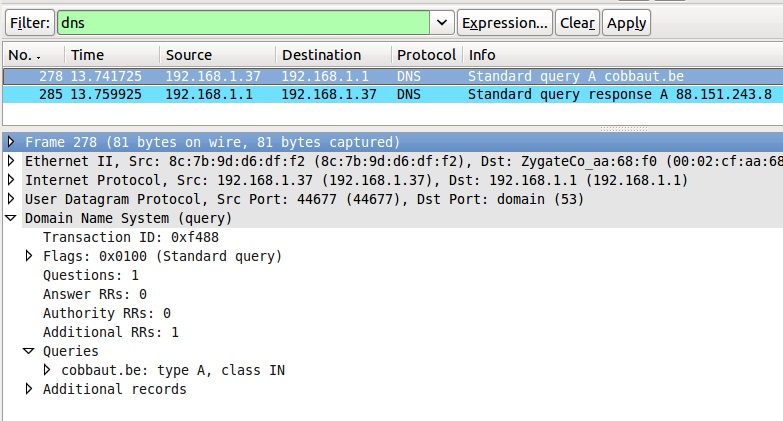
7. What happens when you query for the same domain name more than once ?
8. Why does it say "non-authoritative answer" ? When is a dns server authoritative ?
9. You can also use dig instead of nslookup.
root@debian7:~# dig @10.104.33.30 linux-training.be +short
188.93.155.87
root@debian7:~#10. How can we avoid having to set the server in dig or nslookup ?
Change this:
root@debian7:~# cat /etc/resolv.conf
nameserver 10.46.101.1
root@debian7:~#into this:
root@debian7:~# cat /etc/resolv.conf
nameserver 10.104.33.30
root@debian7:~#11. When you use dig for the first time for a domain, where is the answer coming from ? And the second time ? How can you tell ?
1. Instead of only cachng the information from other servers, we will now make our server authoritative for our own domain.
2. I choose the top level domain .local and the domain paul.local and put the information in /etc/bind/named.conf.local.
root@debian7:~# cat /etc/bind/named.conf.local
//
// Do any local configuration here
//
// Consider adding the 1918 zones here, if they are not used in your
// organization
//include "/etc/bind/zones.rfc1918";
zone "paul.local" IN {
type master;
file "/etc/bind/db.paul.local";
allow-update { none; };
};3. Also add a zone database file, similar to this one (add some A records for testing). Set the Refresh and Retry values not too high so you can sniff this traffic (this example makes the slave server contact the master every hour).
root@debian7:~# cat /etc/bind/db.paul.local
; zone for classroom teaching
$TTL 86400
@ IN SOA debianpaul.paul.local. root.paul.local (
2014100101 ; Serial
1h ; Refresh
1h ; Retry
2h ; Expire
900 ) ; Negative Cache TTL
;
; name servers
;
IN NS ns1
IN NS debianpaul
IN NS debian7
;
; servers
;
debianpaul IN A 10.104.33.30
debian7 IN A 10.104.33.30
ns1 IN A 10.104.33.30
;www IN A 10.104.33.30
root@debian7:~#Note that the www record is commented out, so it will not resolve.
If you are confident that your dns server works, then set it as default and only dns server in /etc/resolv.conf.
root@debian7:~# cat /etc/resolv.conf
nameserver 10.104.33.30
root@debian7:~#In case you also use dhclient, you will need to add your dns server to /etc/dhcp/dhclient.conf.
root@debian7:~# diff /etc/dhcp/dhclient.conf /etc/dhcp/dhclient.conf.original
21c21
< prepend domain-name-servers 10.104.33.30;
---
> #prepend domain-name-servers 127.0.0.1;
23,24c23
< # domain-name, domain-name-servers, domain-search, host-name,
< domain-name, domain-search, host-name,
---
> domain-name, domain-name-servers, domain-search, host-name,
root@debian7:~#The above screenshot shows that 10.104.33.30 is now a default option that the dhcp client should no longer request from the dhcp server.
Adjust /etc/hosts to reflect your domain name and verify with hostname and dnsdomainname.
root@debian7:~# grep debian7 /etc/hosts 127.0.1.1 debian7.paul.local debian7 root@debian7:~# hostname debian7 root@debian7:~# hostname --fqdn debian7.paul.local root@debian7:~# dnsdomainname paul.local
Consider the following screenshot:
root@debian7b:~# cat /etc/resolv.conf nameserver 10.104.33.30 root@debian7b:~# ping -c1 www ping: unknown host www root@debian7b:~# vi /etc/resolv.conf root@debian7b:~# cat /etc/resolv.conf nameserver 10.104.33.30 domain paul.local root@debian7b:~# ping -c1 www PING www.paul.local (10.104.33.31) 56(84) bytes of data. 64 bytes from 10.104.33.31: icmp_req=1 ttl=64 time=0.021 ms --- www.paul.local ping statistics --- 1 packets transmitted, 1 received, 0% packet loss, time 0ms rtt min/avg/max/mdev = 0.021/0.021/0.021/0.000 ms root@debian7b:~#
Adding the domain paul.local directive to /etc/resolv.conf allows omitting the domain when using hostnames.
You can accomplish this feature automatically by adjusting dhclient.conf.
root@debian7:~# grep paul.local /etc/dhcp/dhclient.conf
prepend domain-name "paul.local";
prepend domain-search "paul.local";
root@debian7:~#4. Restart the DNS server and check your zone in the error log.
root@debian7:~# service bind9 restart Stopping domain name service...: bind9. Starting domain name service...: bind9. root@debian7:~# grep paul.local /var/log/syslog Oct 6 09:22:18 debian7 named[2707]: zone paul.local/IN: loaded seria\ l 2014100101 Oct 6 09:22:18 debian7 named[2707]: zone paul.local/IN: sending noti\ fies (serial 2014100101)
5. Use dig or nslookup (or even ping) to test your A records.
root@debian7:~# ping -c1 ns1.paul.local PING ns1.paul.local (10.104.33.30) 56(84) bytes of data. 64 bytes from 10.104.33.30: icmp_req=1 ttl=64 time=0.006 ms --- ns1.paul.local ping statistics --- 1 packets transmitted, 1 received, 0% packet loss, time 0ms rtt min/avg/max/mdev = 0.006/0.006/0.006/0.000 ms root@debian7:~# ping -c1 www.paul.local ping: unknown host www.paul.local
Note that the www record was commented out, so it should fail.
root@debian7:~# dig debian7.paul.local
; <<>> DiG 9.8.4-rpz2+rl005.12-P1 <<>> debian7.paul.local
;; global options: +cmd
;; Got answer:
;; ->>HEADER<<- opcode: QUERY, status: NOERROR, id: 50491
;; flags: qr aa rd ra; QUERY: 1, ANSWER: 1, AUTHORITY: 3, ADDITIONAL: 2
;; QUESTION SECTION:
;debian7.paul.local. IN A
;; ANSWER SECTION:
debian7.paul.local. 86400 IN A 10.104.33.30
;; AUTHORITY SECTION:
paul.local. 86400 IN NS ns1.paul.local.
paul.local. 86400 IN NS debian7.paul.local.
paul.local. 86400 IN NS debianpaul.paul.local.
;; ADDITIONAL SECTION:
ns1.paul.local. 86400 IN A 10.104.33.30
debianpaul.paul.local. 86400 IN A 10.104.33.30
;; Query time: 4 msec
;; SERVER: 10.104.33.30#53(10.104.33.30)
;; WHEN: Mon Oct 6 09:35:25 2014
;; MSG SIZE rcvd: 141
root@debian7:~#6. Our primary server appears to be up and running. Note the information here:
server os : Debian 7 ip address : 10.104.33.30 domain name: paul.local server name: ns1.paul.local
1. A slave server transfers zone information over the network from a master server (a slave can also be a master). A primary server maintains zone records in its local file system. As an exercise, and to verify the work of all students, set up a slave server of all the master servers in the classroom.
2. Before configuring the slave server, we may have to allow transfers from our zone to this server. Remember that this is not very secure since transfers are in clear text and limited to an ip address. This example follows our demo from above.
Imagine a student named Jesse having completed the setup as shown before, with the domain name jesse.local and the ip address 10.104.15.20. The goal is to have a slave server of paul.local on Jesse's computer and a slave zone of jesse.local on my computer.
Below is an example of an allow-transfer statement. Careful, maybe the default allows transfer to any.
root@debian7:/etc/bind# cat named.conf.local
//
// Do any local configuration here
//
// Consider adding the 1918 zones here, if they are not used in your
// organization
//include "/etc/bind/zones.rfc1918";
zone "paul.local" IN {
type master;
file "/etc/bind/db.paul.local";
allow-update { none; };
allow-transfer { 10.104.15.20; };
};3. With the configuration below I can make my server a slave for the jesse.local zone.
root@debian7:/etc/bind# tail -6 named.conf.local zone "jesse.local" IN { type slave; file "/var/cache/named/db.jesse.local"; masters { 10.104.15.20; }; }; root@debian7:/etc/bind# mkdir /var/cache/named/ root@debian7:/etc/bind# chown bind:bind /var/cache/named/ root@debian7:/etc/bind# ls -ld /var/cache/named/ drwxr-xr-x 2 bind bind 4096 Oct 1 20:01 /var/cache/named/
Note that we put the slave zones in /var/cache/named and not in /etc/bind.
4. Restarting bind on the slave server should transfer the zone database file. Verify this in /var/log/syslog. (time and date are truncated from the screenshot, and Jesse did not use the current date in the serial number...)
root@debian7:/etc/bind# grep jesse /var/log/syslog
named[2731]: zone jesse.local/IN: Transfer started.
named[2731]: transfer of 'jesse.local/IN' from 10.104.15.20#53: connected u\
sing 10.104.33.30#44719
named[2731]: zone jesse.local/IN: transferred serial 20110516
named[2731]: transfer of 'jesse.local/IN' from 10.104.15.20#53: Transfer co\
mpleted: 1 messages, 8 records, 239 bytes, 0.001 secs (239000 bytes/sec)And the contents of the slave zone:
root@debian7:/etc/bind# cat /var/cache/named/db.jesse.local
$ORIGIN .
$TTL 604800 ; 1 week
jesse.local IN SOA ns.jesse.local. root.jesse.local.jesse.local. (
20110516 ; serial
300 ; refresh (5 minutes)
200 ; retry (3 minutes 20 seconds)
2419200 ; expire (4 weeks)
604800 ; minimum (1 week)
)
NS ns.jesse.local.
$ORIGIN jesse.local.
anya A 10.104.15.1
mac A 10.104.15.30
ns A 10.104.15.20
ubu1010srv A 10.104.15.20
www A 10.104.15.25
root@debian7:/etc/bind#1. Install bind9 and verify with a sniffer how it works.
2. Add a forwarder and verify that it works.
3. Create a primary forward lookup zone named yourname.local with at least two NS records and four A records.
4. Use dig and nslookup to verify your NS and A records.
5. Create a slave of your primary zone (on another server) and verify the zone transfer.
6. Set up two primary zones on two servers and implement a conditional forwarder (you can use the two servers from before).
1. Install bind9 and verify with a sniffer how it works.
You should see queries to the root name servers with tcpdump or wireshark.
2. Add a forwarder and verify that it works.
The forwarder van be added in named.conf.options as seen in the theory.
3. Create a primary forward lookup zone named yourname.local with at least two NS records and four A records.
This is literally explained in the theory.
4. Use dig and nslookup to verify your NS and A records.
This is literally explained in the theory.
5. Create a slave of your primary zone (on another server) and verify the zone transfer.
This is literally explained in the theory.
6. Set up two primary zones on two servers and implement a conditional forwarder (you can use the two servers from before).
A conditional forwarder is set in named.conf.local as a zone. (see the theory on forwarder)